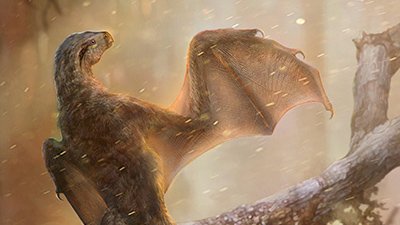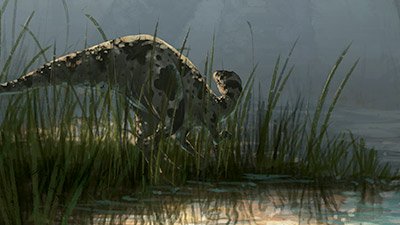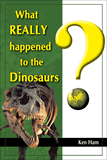Polar Dinosaurs
Could they survive the cold?
What do dinosaur bones found in the far north of Alaska say about the creatures?
At a Glance
- Dinosaur bones from the far north of Alaska prompt scientists to ask if the beasts could have survived the cold.
- Were dinosaurs migratory? Or were they warm-blooded?
- Even the typical dinosaur extinction theory is in question.
What were dinosaurs doing near the North Pole? And how did they survive? Last week’s NOVA program on “Arctic Dinosaurs” examined the riddle of dinosaur fossils in the cold Arctic of Alaska.
The program opens with paleontologists excavating a jumble of dinosaur bones near Alaska’s Coleville River, where a total of eight separate species have been discovered in two sites. Included are meat-eaters gorgosaurus, troodon, and dromaeosaurus, along with plant-eaters edmontosaurus, pachyrhinosaurus, pachycephalosaurus, and thescelosaurus. “The unexpected discovery of so many species living in the arctic is leading scientists to rethink old assumptions about dinosaur biology,” explains the program’s narrator.
Most of the bones the paleontologists have discovered are buried together in numerous fragments. “It’s as if somebody took 15 pachyrhinosaurus, dumped them in a blender for 30 seconds, and then poured all the mess out into a large batch of concrete and let it solidify for 70 million years,” says Ron Tykoski, one of the paleontologists.
But dinosaurs aren’t usually pictured roaming in the icy, permafrost-saturated landscape of northern Alaska. Hans-Dieter Sues, one of the program’s featured scientists, explicates the question. “The traditional view was that dinosaurs were all overgrown reptiles that lived under tropical conditions. When we found polar dinosaurs, however, it was driven home to everyone that dinosaurs could live under different—and thrive under very different climate conditions.” So what was such a diverse group of dinosaurs doing in that landscape? How did they survive—and how did they die?
Dinosaurs aren’t usually pictured roaming in the icy, permafrost-saturated landscape of northern Alaska.
At one of the fossil sites paleontologists uncover a graveyard of 14 unique pachyrhinosauruses—which doesn’t exactly fit within the slow-and-gradual model of fossilization. What caused so many dinosaurs to be buried together? One of the paleontologists, Anthony Fiorillo, offers an explanation: “A density of bone so high that it’s easy to envision this being a jam in a river channel. These animals were transported downriver somewhere. And presumably they created their own little logjam, except there was a bone jam in a river channel.”
The bigger question, though, is how these animals survived in what is today the harsh climate of Alaska. “What did they do during the wintertime? How was life up here the same or different than what we see in the lower latitudes?” Fiorillo asks. With the help of paleobotanist Robert Spicer, the team tries to hone in on what the climate of Alaska may have been 70 million years ago, when they believe the dinosaurs they’ve unearthed would have lived. Spicer uses fossil plants—in this case, everything from ferns to conifers—to estimate what the temperature once was. “When I find a fossil leaf, it tells me something, it’s like a messenger from the past,” Spicer claims. He concludes that the average temperature around what is now the Coleville River was once 42˚F (5˚C), significantly warmer (by about 30˚F [17˚C]) than the area is today. Paleoichnologist Steve Hasiotis, who studies fossilized tracks made by insects, worms, and other small creatures, confirms that the area was once “a rich ecosystem in the summer, capable of supporting creatures of all sizes and a much greater diversity of plants and animals than is found in Alaska today,” in the narrator’s words.
But there’s a catch. In far northern (and southern) latitudes, the extremes between summer and winter can be very different, since daily sunlight varies wildly. While the ancient summer may have seen high temperatures in the 70s (Fahrenheit; 20s Celsius), winters may have nonetheless been icy and snowy. Even today, summer highs and winter lows are as much as 100˚F (56˚C) apart. So the question is, what did the dinosaurs do when winter came?
The first speculation the scientists make is that perhaps the dinosaurs endured the harsh climate. While that would have been tough for plant-eaters, who would have been forced to survive on decaying plants, roots, and bark, meat-eaters such as troodon may have enjoyed prime feasting during the winter months. A look at troodon’s eye sockets and cranial cavity suggests the animal had large eyes and a large optic lobe in the brain—perhaps allowing it to hunt quite well in the long night of an Alaskan winter.
The other idea is that the plant-eaters may have gone through annual migrations, much like mammal herds do today. But it would have been a long journey, and the younger dinosaurs may have been too small to make such a distant migration. Because of that, Fiorillo’s team thinks the migratory theory is unlikely. “We argued that these animals lived here year ’round,” he explains. “That opened up a whole bunch of interesting biological questions, like how did they survive the seasonality?”
One of the specific questions it raises is whether dinosaurs were cold-blooded or warm-blooded, a long-standing question in paleontology.1 If they were warm-blooded, perhaps that would help explain how dinosaurs could have survived such a cold climate.
Data from the lab of Anusuya Chinsamy-Turan of the University of Cape Town suggests that perhaps these Alaskan dinosaurs were warm-blooded. Looking at one of the bones from one of the Alaskan dig sites, Chinsamy-Turan fails to identify markings in the bone indicative of the start-stop growth of cold-blooded species as the weather fluctuates. The bone appears more similar to a mammal or bird than a reptile. “I suspect that perhaps this animal was very well adapted to the environment in which it lived,” she opines.
“Today, biologists increasingly understand that there exist degrees of warm-bloodedness and cold-bloodedness in the animal world,” the narrator comments. “It’s not always one or another. Dinosaurs likely had their own unique solution to the body temperature problem, which allowed them to survive for millions of years in the toughest seasonal conditions their world had to offer.”
The conclusion—warm-blooded, cold-enduring dinosaurs—also stands against the most widely accepted (evolutionary) model of dinosaur extinction, which holds that a meteorite impact changed the climate enough to kill off warmth-loving dinosaurs. Instead, Fiorillo and Spicer think the dinosaurs were on a gradual decline, and that overall climate changes slowly doomed the dinosaurs.
How Does it Fit within the Creation Model?
The program, of course, had its fair share of evolutionary presuppositions. Most prominent was the repeated date of 70 million years ago; also, one justification given of the warm-bloodedness of some dinosaurs was that (warm-blooded) birds supposedly evolved from dinosaurs.
Removing those bits of propaganda, the remaining discoveries are easily explained by the Creation/Flood models. First of all, keep in mind that the fossils discovered in sediments in Alaska would have been buried by a global Flood, which explains why numerous skeletons have been found buried together. However, we don’t know what the climate was like before the Flood. It is possible that even in northern latitudes the weather was much warmer year-round, thus negating the supposition that dinosaurs in Alaska proves they were warm-blooded. Perhaps the best explanation for the fossils, including the fossilized plants, found so far north is that the temperatures weren’t so cold until after the Flood-caused Ice Age. Furthermore, since the global Flood resulted in a dynamic repositioning of the continents, we can’t be sure how far north modern-day Alaska was before the Flood. Perhaps its latitude wasn’t as extreme as the evolutionists on NOVA suggest.
However, the work of Anusuya Chinsamy-Turan seems to suggest that these dinosaurs did not experience the start-stop growth cycles of cold-blooded creatures that would have occurred even if Alaska’s temperature fluctuations weren’t as extreme as the program suggests. It is certainly possible (i.e., not unbiblical) that God created some dinosaurs that were warm-blooded, though since our knowledge of dinosaurs is only through indirect methods, we may never be able to say for sure. Many evolutionists are adamant that dinosaurs were cold-blooded, as has long been assumed, whereas others are motivated by their belief in dino-to-bird evolution to find evidence showing some dinosaurs were warm-blooded (see the section “Problems with Dinosaurs Evolving into Birds: Warm-blooded vs. cold-blooded” in Did Dinosaurs Turn into Birds? for more).
Finally, when it comes to the team’s objections to the usual dinosaur extinction theory, we agree—but for different reasons. The massive catastrophe that wiped out land-dwelling/airbreathing life on earth, including most dinosaurs, was not an asteroid, but the Flood. But Noah would have taken dinosaurs (two of each kind) on the Ark, and those would have continued the dinosaur line after the Flood. Environmental factors, along with possible human predation, seem to have driven those last dinosaurs to extinction some time later, just like many other animals that have gone extinct.
If there is one important take-away point from the NOVA program, it’s to remember that our knowledge of dinosaurs is entirely indirect, based on interpreting fossil remains and suggesting what the beasts may have been like. The role of presuppositions and interpretation is therefore paramount. While evolutionists would like to paint creationists as having to accommodate dinosaurs into our presupposed worldview (including Noah’s Ark, the Flood, thousands of years, etc.), the reality is that evolutionists must do the same thing within their worldview: incorporating dinosaurs into the evolutionary time scale and phylogenetic tree.
Ultimately, when we look at the evidence through biblical lenses, we can make sense of what we find. In this case, we find dinosaurs buried catastrophically and surrounded by evidence of a warmer climate, such as Alaska must have enjoyed before catastrophic Flood-caused plate tectonic movement and the Flood-caused Ice Age.
Further Reading
- What Really Happened to the Dinosaurs?
- Did Dinosaurs Turn into Birds?
- Can Catastrophic Plate Tectonics Explain Flood Geology?
- A Catastrophic Breakup
- Where Does the Ice Age Fit?
- Was There Really a Noah’s Ark & Flood?
- Why Shouldn’t Christians Accept Millions of Years?
- Get Answers: Dinosaurs, Fossils, The Flood, Ice Age, Plate Tectonics
Footnotes
- The terms “cold-blooded” and “warm-blooded” have fallen somewhat out of favor in many scientific circles, since they inaccurately suggest that some animals have cold blood and others have warm blood. Rather, cold-blooded organisms, also known as ectotherms, do not produce heat internally or maintain constant body temperature (poikilothermy), whereas warm-blooded organisms, known as endotherms, produce heat internally and maintain constant body temperature (homeothermy).
Recommended Resources

Answers in Genesis is an apologetics ministry, dedicated to helping Christians defend their faith and proclaim the good news of Jesus Christ.
- Customer Service 800.778.3390
- Available Monday–Friday | 9 AM–5 PM ET
- © 2025 Answers in Genesis






